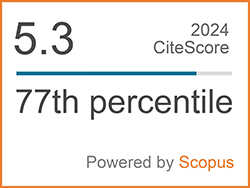Enhancing Antioxidant Activity and Bioactive Compound Production of Cordyceps Mushroom Using Quinoa as an Alternative Substrate
Abstract
Keywords
[1] P. K. Ouzouni, D. Petridis, W. D. Koller, and K. A. Riganakos, “Nutritional value and metal content of wild edible mushrooms collected from West Macedonia and Epirus, Greece,” Food Chemistry, vol. 115, no. 4, pp. 1575–1580, 2009, doi: 10.1016/j.foodchem.2009.02.014.
[2] P. Pintathong, P. Chomnunti, S. Sangthong, A. Jirarat, and P. Chaiwut, “The feasibility of utilizing cultured Cordyceps militaris residues in cosmetics: Biological activity assessment of their crude extracts,” Journal of Fungi (Basel), vol. 7, no. 11, p. 973, 2021, doi: 10.3390/ jof7110973.
[3] A. R. Phull, M. Ahmed, and H. J. Park, “Cordyceps militaris as a bio functional food source: Pharmacological potential, anti-inflammatory actions and related molecular mechanisms,” Microorganisms, vol. 10, no. 2, p. 405, 2022, doi: 10.3390/microorganisms10020405.
[4] Shweta, S. Abdullah, Komal, and A. Kumar, “A brief review on the medicinal uses of Cordyceps militaris,” Pharmacological Research - Modern Chinese Medicine, vol. 7, no. 2, p. 100228, 2023, doi: 10.1016/j.prmcm.2023.100228.
[5] T. T. Nguyen, “Extraction of adenosine and cordycepin from spent solid medium of medicine fungi Cordyceps militaris,” Vietnam Journal of Science and Technology, vol. 56, p. 221, 2018, doi: 10.1016/j.prmcm.2023.100228.
[6] P. Pathania, M. Joshi, and A. Sagar., “Morphological, Physiological and Molecular studies on wildly collected Cordyceps militaris from North West Himalayas, India,” European Journal of Biotechnology and Bioscience, vol. 3, pp. 53–62, 2015.
[7] K. Eiamthaworn, T. Kaewkod, S. Bovonsombut, and Y. Tragoolpua, “Efficacy of Cordyceps militaris extracts against some skin pathogenic bacteria and antioxidant activity,” Journal of Fungi (Basel), vol. 8, no. 4, p. 327, Mar. 2022, doi: 10.3390/jof8040327.
[8] S. Brewer, “Natural Antioxidants: Sources, compounds, mechanisms of action, and potential applications,” Comprehensive Reviews in Food Science and Food Safety, vol. 10, no. 4, pp. 221–247, 2011, doi: 10.1111/j.1541-4337.2011.00156.x.
[9] C. H. Dong, T. Yang, and T. Lian, “A comparative study of the antimicrobial, antioxidant, and cytotoxic activities of methanol extracts from fruit bodies and fermented mycelia of caterpillar medicinal mushroom Cordyceps militaris (Ascomycetes),” International Journal of Medicinal Mushrooms, vol. 16, no. 15, pp. 485–495, 2014, doi: 10.1615/intjmedmushrooms. v16.i5.70.
[10] L. Nguyen, V. Le, B. Nguyen, N. Ngo, H. Nguyen, Q. Dinh, and S. Mulla, “Cultural characteristics and cordycepin production of some Cordyceps militaris strains under artificial cultivation conditions,” Biotechnologia, 2020, doi: 10.5114/bta.2020.94772.
[11] X. Y. Yu, Y. Zou, Q. W. Zheng, F. X. Lu, D. H. Li, L. Q. Guo, and J. F. Lin, “Physicochemical, functional and structural properties of the major protein fractions extracted from Cordyceps militaris fruit body,” Food Research International, vol. 142, 2021, Art. no. 110211, doi: 10.1016/j.foodres.2021.110211.
[12] K. J. Jędrejko, J. Lazur, and B. Muszyńska, “Cordyceps militaris: An overview of its chemical constituents in relation to biological activity,” Foods, vol. 10, p. 3390, 2021, doi: 10.3390/foods 10112634.
[13] O. J. Olatunji, J. Tang, A. Tola, F. Auberon, O. Oluwaniyi, and Z. Ouyang., “The genus Cordyceps: An extensive review of its traditional uses, phytochemistry and pharmacology,” Fitoterapia, vol. 129, pp. 293–316, 2018, doi: 10.1016/j.fitote.2018.05.010.
[14] A. Romano, “Sustainable crops for food security: Quinoa (Chenopodium quinoa Willd.),” Encyclopedia of Food Security and Sustainability, vol. 1, pp. 399–402, 2018, doi: 10.1016/B978-0-08-100596-5.22573-0.
[15] C. Motta, I. Castanheira, G. B. Gonzales, I. Delgado, D. Torres, M. Santos, and A. S. Matos, “Impact of cooking methods and malting on amino acids content in amaranth, buckwheat and quinoa,” Journal of Food Composition and Analysis, vol. 76, pp. 58–65, 2019, doi: 10.1016/ j.jfca.2018.10.001.
[16] R. Repo-Carrasco-Valencia, J. Hellström, J. M. Pihlava, and P. Mattila, “Flavonoids and other phenolic compounds in Andean indigenous grains: Quinoa (Chenopodium quinoa), kañiwa (Chenopodium pallidicaule) and kiwicha (Amaranthus caudatus),” Food Chemistry, vol. 120, pp. 128–133, 2010, doi: 10.1016/j.foodchem. 2009.09.087.
[17] J. Sánchez-García, S. Muñoz-Pina, J. García-Hernández, A. Heredia, and A. Andrés, “Fermented quinoa flour: Implications of fungal solid-state bioprocessing and drying on nutritional and antioxidant properties,” International Journal of Food Science and Technology, vol. 182, p. 114885, 2023, doi: 10.1016/j.lwt.2023.114885.
[18] Y. Tang, X. Li, B. Zhang, P. X. Chen, R. Liu, and R. Tsao, “Characterization of phenolics, betanins and antioxidant activities in seeds of three Chenopodium quinoa Willd. genotypes,” Food Chemistry, vol. 166, pp. 380–388, 2015, doi: 10.1016/j.foodchem.2014.06.018.
[19] J. Y. Liu, C. P. Feng, X. Li, M. C. Chang, J. L. Meng, and L. J. Xu, “Immunomodulatory and antioxidative activity of Cordyceps militaris polysaccharides in mice,” International Journal of Biological Macromolecules, vol. 86, pp. 594–598, 2016, doi: 10.1016/j.ijbiomac. 2016.02.009.
[20] X. F. Wu, M. Zhang, and Z. Li, “Influence of infrared drying on the drying kinetics, bioactive compounds and flavor of Cordyceps militaris,” Food Science and Technology, vol. 111, pp. 790–798, 2019, doi: 10.1016/j.lwt.2019. 05.108.
[21] S. Tinrat, “Phytochemical screening, antioxidant and antimicrobial assessment of Pluchea indica (l.) Less extract as an active ingredient in natural lotion bar,” International Journal of Current Pharmaceutical Research, pp. 51–57, 2021, doi: 10.22159/ijcpr.2021v13i2.41555.
[22] S. Tinrat and C. Singhapol, “Evaluation of antioxidant and antibacterial activities of vernonia amygdalina leaf extracts as an auxiliary in natural hair shampoo,” Asian Journal of Pharmaceutical and Clinical Research, pp. 50–57, 2020, doi: 10.22159/ajpcr.2020. v13i10.38581.
[23] K. Phoungthong, W. Aiphuk, T. Maneerat, T. Suwunwong, P. Choto, and P. Chomnunti., “Utilization of corncob biochar in cultivation media for cordycepin production and biomass of Cordyceps militaris,” Sustainability, vol. 14, no. 15, p.9362, 2022, doi: 10.3390/su14159362.
[24] S. Jindarak, B. Wiengmoon, K. Sujipuli, and S. Prasarnpun, “Mycelial growth and fruiting body production of Cordyceps militaris in different culture chambers,” NU. International Journal of Science, vol. 16, pp. 58–68, 2019.
[25] W. Liu, M. Dun, X. Liu, G. Zhang, and J. Ling, “Effects on total phenolic and flavonoid content, antioxidant properties, and angiotensin I-converting enzyme inhibitory activity of beans by solid-state fermentation with Cordyceps militaris,” International Journal of Food Properties, vol. 25, pp. 477–491, 2022, doi: 10.1080/10942912.2022.2048009.
[26] Thai Food and Drug Administration (FDA). “Guidelines and criteria for the approval of Cordyceps militaris (golden cordyceps) as a food ingredient.” food.fda.moph.go.th. https://food.fda. moph.go.th/law/data/announ_fda/GoldCordycepsGuide.pdf (accessed Jan. 24, 2025).
[27] W. Vongsangnak, N. Raethong, W. Mujchariyakul, N. N. Nguyen, H.W. Leong, and K. Laoteng, “Genome-scale metabolic network of Cordyceps militaris useful for comparative analysis of entomopathogenic fungi,” Gene, vol. 626, pp. 132–139, 2017, doi: 10.1016/j.gene. 2017. 05.027.
[28] H. W. Woldemariam, G. Bultosa, and L. Pant, “Nutritional contents of three edible oyster mushrooms grown on two substrates at Haramaya, Ethiopia, and sensory properties of boiled mushroom and mushroom sauce,” International Journal of Food Science and Technology, vol. 46, no. 4, pp. 732–738, 2011, doi: 10.1111/j.1365-2621.2010.02543.x.
[29] R. I. Limón, E. Peñas, M. I. Torino, C. Martínez-Villaluenga, M. Dueñas, and J. Frias, “Fermentation enhances the content of bioactive compounds in kidney bean extracts,” Food Chemistry, vol. 172, pp. 343–352, 2015, doi: 10.1016/j.foodchem.2014.09.084.
[30] E. Espinosa-Páez, M. G. Alanis-Guzmán, C. E. Hernández-Luna, J. G. Báez-González, C. A. Amaya-Guerra, and A. M. Andrés-Grau., “Increasing antioxidant activity and protein digestibility in phaseolus vulgaris and avena sativa by fermentation with the Pleurotus ostreatus fungus,” Molecules, vol. 22, no. 12, p. 2275, 2017, doi: 10.3390/molecules 22122275.
[31] J. Isanapong, T. Krailoekpaiboon, W. Noiniyom, and S. Panchal, “Utilization of organic wastes for laccase production by Pleurotus ostreatus,” Applied Science and Engineering Progress, vol. 10, no. 3, pp. 239–244, 2017, doi: 10.14416/ j.ijast.2017.08.003.
[32] S. Singh, M. Arif, S. Ranjan, and M. Nasim., “Comparative in vitro antioxidant activity of natural and cultured Ophiocordyceps Sinensis,” International Journal of Advancement in Life Sciences Research, vol. 1, no. 3, pp. 30–39, 2018, doi: 10.31632/ijalsr.2018v01i03.005.
[33] R. Yosmethakun and N. Singpoonga, “Cordycepin and adenosine production from Cordyceps militaris in cereal medium,” Agricultural Science Journal, vol. 49, pp. 168–171, 2018.
[34] N. Cohen, J. Cohen, M. D. Asatiani, V. K. Varshney, H. T. Yu, Y. C. Yang, Y. H. Li, J. L. Mau, and S. P. Wasser, “Chemical composition and nutritional and medicinal value of fruit bodies and submerged cultured mycelia of culinary-medicinal higher Basidiomycetes mushrooms,” International Journal of Medicinal Mushrooms, vol. 16, pp. 273–291, 2014, doi: 10.1615/intjmedmushr.v16.i3.80.
[35] J. S. Chan, G. S. Barseghyan, M. D. Asatiani, and S. P. Wasser, “Chemical composition and medicinal value of fruiting bodies and submerged cultured mycelia of caterpillar medicinal fungus Cordyceps militaris CBS-132098 (Ascomycetes),” International Journal of Medicinal Mushrooms, vol. 17, no.7, pp. 649–659, 2015, doi: 10.1615/intjmedmushrooms. v17.i7.50.
[36] S. Rashid, C. Ukaegbu, H. Hamid, and O. Alara., “Evaluation of antioxidant and antibacterial activities of the stems of Flammulina velutipes and Hypsizygus tessellatus (white and brown var.) extracted with different solvents,” Journal of Food Measurement and Characterization, vol. 12, pp. 1–15, 2018, doi:10.1007/s11694-018-9810-8.
[37] K. Jędrejko, K. Kała, K. Sułkowska-Ziaja, A. Krakowska, P. Zięba, K. Marzec, A. Szewczyk, A. Sękara, J. Pytko-Polończyk, and B. Muszyńska, “Cordyceps militaris-fruiting bodies, mycelium, and supplements: Valuable component of daily diet,” Antioxidants (Basel), vol. 11, no. 10, p. 1861, 2022, doi: 10.3390/antiox11101861.
[38] N. Zlatić, D. Jakovljević, and M. Stanković., “Temporal, lant part, and interpopulation variability of secondary metabolites and antioxidant activity of Inula helenium L.,” Plants (Basel), vol. 8, no. 6, p. 179, 2019, doi: 10.3390/ plants8060179.
[39] F. S. Reis, L. Barros, R. C. Calhelha, A. Cirić, L. J. van Griensven, M. Soković, and I. C. Ferreira, “The methanolic extract of Cordyceps militaris (L.) Link fruiting body shows antioxidant, antibacterial, antifungal and antihuman tumor cell lines properties,” Food and Chemical Toxicology, vol. 62, pp. 91–98, 2013, doi: 10.1016/j. fct.2013.08.033.
[40] N. Dang, D. Hung, C. L. Wang, L. Lay, and V. Phuong, “Impact of different fermentation characteristics on the production of mycelial biomass, extra-cellular polysaccharides, intra-cellular polysac- charides, and on the antioxidant activities of Cordyceps militaris (L.) Fr. (strains AG-1, PSJ-1),” Acta agriculturae Slovenica, vol. 116, no. 2, pp. 337–350, 2020, doi: 10.14720/aas.2020.116.2.1104.
[41] J. Zhang, C. Wen, Y. Duan, H. Zhang, and H. Ma, “Advance in Cordyceps militaris (Linn) Link polysaccharides: Isolation, structure, and bioactivities: A review,” International Journal of Biological Macromolecules, vol. 132, pp. 906–914, 2019, doi: 10.1016/j.ijbiomac.2019. 04.020.
[42] S. A. Ashraf, A. E. O. Elkhalifa, A. J. Siddiqui, M. Patel, A. M. Awadelkareem, M. Snoussi, and S. Hadi, “Cordycepin for health and wellbeing:A potent bioactive metabolite of an entomopathogenic Cordyceps medicinal fungus and its nutraceutical and therapeutic potential,” Molecules, vol. 25, no. 12, 2020, doi: 10.3390/ molecules2512273.DOI: 10.14416/j.asep.2025.07.005
Refbacks
- There are currently no refbacks.
 Applied Science and Engineering Progress
Applied Science and Engineering Progress







